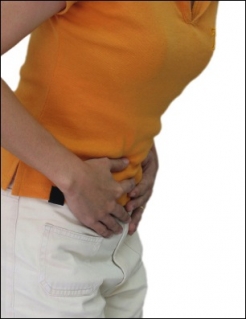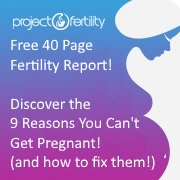Endometriosis Symptoms
Discover The Overlooked Signs of Diagnosis
By Paul J.O'Brien B.A., N.C.E.H.S., Dip. Acu., Adv. Dip. OBB, Cert Clin. Med, Cert.CHM, Pn1, PN-SSR, PN-NCA, M.AFPA, M.ETCMA, M.C.Th.A.
Endometriosis symptoms are often greatly misunderstood and, as a result, shockingly, endometriosis often goes undiagnosed! This is because endometriosis is not always accompanied by symptoms. It is often only diagnosed when couples have been struggling to conceive and investigations are carried out that evidence is found. Then getting pregnant with Endometriosis can be a problem....but I'll discuss that in more detail in a moment. For now, I want focus on some of the endometriosis symptoms you may experience..
Endometriosis Symptoms
 Painful cramps are one of the symptoms of endometriosis
Painful cramps are one of the symptoms of endometriosisIn cases where there are endometriosis symptoms, one of the first is that a woman usually suffers from what is called dysmenorrhoea, extremely painful periods. The most common signs of endometriosis (the percentage of patients who experience those symptoms) include:
- Progressive dysmenorrhoea (painful periods) (97%)
- chronic lumbar (low back), pelvic and abdominal pain (62%)
- dyspareunia (painful intercourse) (59%)
- dyschezia (painful bowel movement) (68%)or dysuria (painful urination);
- menorrhagia (heavy menstrual bleeding); (65.3%)
- Endometriosis nausea and vomiting, (57.7%)
- Pre- or intermenstrual (in between periods) spotting.
- Pain during ovulation
- Diarrhoea (79%)
- Irregular bleeding
- Dizziness, headaches during the period (595)
- Low-grade fever (29.4%)
- Low resistance to infection (39.1%)
- Unexplainable fatigue (64% - 82.1%)
- Abdominal bloating that is associated with menstruation (1)
Progressive dysmenorrhoea (painful periods)
During menstruation, the period, women often experience abdominal cramps and tenderness of the breasts. This is said to be due to the estrogen level that fluctuates during that time. However, for women with endometriosis, the pain gets worse over time. This symptom is usually neglected as women often think of it as part of their usual dysmenorrhea attacks.
Chronic lumbar, pelvic and abdominal pain
This may well be carried over to experiencing chronic pain, usually on the lower back, pelvic and abdominal areas. As a lot of women experience a radiating pain during dysmenorrhea. The pain radiates from abdomen to the lumbar area. However, women with endometriosis also experience dyspareunia, or painful sexual intercourse. There might be an inflammation (swelling and reddening) of the vaginal lining, causing pain upon contact or friction during intercourse.
Dyschezia or Dysuria
If the misplaced endometrial lining attaches itself to your bowel, kidney or bladder, you may experience dyschezia or dysuria.
Dyschezia is a condition wherein you experience discomfort while defecating.
Dysuria is a condition characterized by painful urination.
In both cases you may experience hematochezia or hematuria wherein blood is found in your feces and urine. Difficulty defecating and urinating may cause internal bleeding and, in turn, infection.
Menorrhagia, heavy menstrual bleeding
Menorrhagia, or heavy menstrual bleeding is not something to shrug off. It may manifest itself as prolonged menstrual bleeding, heavy menstrual bleeding, or even both. Some women are used to their periods taking two to three weeks to finish. This symptom is tricky to detect as menstrual cycles differ for every woman.
Endometriosis Nausea
Nausea and vomiting, are a common occurrence during dysmenorrhea, but are also endometriosis symptoms. This Endometriosis Nausea can also be a sign that misplaced endometrial lining had attached itself onto your gastrointestinal organs.
Premenstrual and intermenstrual spotting can also be a endometriosis symptoms, and is characterized by blood spots that appear before and in between menstrual cycles.
From a Traditional Chinese Medical point of view we also look at other signs and symptoms such as:
- Fatigue which is often worse after large meals
- A tendency for loose stools
- Cold hands and nose
- A craving for sweets
- A swollen tongue with teeth-marks on its edges
- Pain which is worse at night
- Varicose veins
- Liver or age spots
- A sooty facial complexion
How Traditional Chinese Medicine diagnoses and treats endometriosis is very complicated understands beyond the scope of this article, so I've written a separate one covering it in detail and how to relieve it! For now though, now that we understand what are the most common endometriosis symptoms (mostly LOTS OF PAIN), we should look at understanding what Endometriosis actually is...
Footnotes
(1) Stats based on reporting via the USA Endometriosis Association http://endometriosisassn.org/ retrieved 5/9/17


New! Comments
Have your say about what you just read! Leave me a comment in the box below.